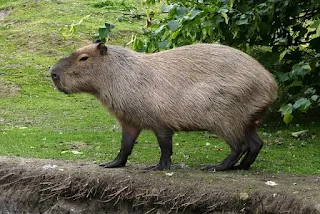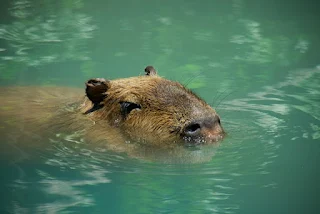Capybara: The World's Largest Rodent and Nature's Chillest Buddy
Introduction:
In the heart of South America, a charismatic giant quietly roams the marshlands and riverbanks, stealing the spotlight with its undeniable charm—the capybara.
Often dubbed nature's most chill buddy, this remarkable rodent has won the hearts of animal enthusiasts worldwide.
Let's embark on a journey into the world of the capybara, uncovering its unique features, social habits, and surprising popularity as a loveable companion.
The Capybara's Vital Stats
Standing as the world's largest rodent, the capybara (Hydrochoerus hydrochaeris) can reach a whopping 150 pounds and measure over 4 feet in length.
Sporting a barrel-shaped body covered in coarse brown fur, these creatures resemble a mix between a guinea pig and a beaver, creating an endearing and distinct appearance.
A Love for Aquatic Adventures
Unlike most rodents, capybaras are avid swimmers. With their partially webbed feet and dense fur, they effortlessly navigate through water, making them equally at home on land and in ponds, rivers, or marshes.
These semi-aquatic beings can stay submerged for several minutes, allowing them to evade predators and cool off during hot days.
Social Butterflies of the Animal Kingdom
What truly sets Capybaras apart is their remarkable social behavior. They are highly gregarious creatures, often found in groups called herds.
These herds can consist of up to 30 capybaras, forming a close-knit community where they share mutual grooming sessions and watch over each other's offspring.
Surprising Companionship
Beyond their wild habitats, capybaras have found an unexpected place in human hearts as delightful companions.
People have adopted capybaras as household pets in some parts of the world, showcasing their gentle nature and adaptability.
With their docile demeanor and a knack for forming deep bonds with their human companions, capybaras have become unlikely but beloved members of various households.
The Science Behind the Cuteness
What makes capybaras so irresistibly adorable? Scientists attribute their charm to a phenomenon called "baby schema," where features like large eyes, round faces, and tiny noses trigger an innate caregiving response in humans.
With their oversized heads and gentle expressions, Capybaras perfectly fit these criteria, making them irresistible to anyone lucky enough to encounter them.
Conservation Concerns
Despite their widespread popularity, capybaras face challenges in the wild. Habitat loss due to human activities, hunting for their meat and fur, and conflicts with agricultural practices threaten capybara populations.
Conservation efforts are crucial to ensuring the survival of these remarkable creatures and maintaining the balance of their ecosystems.
Capybara Fun Facts
Dental Dilemmas: Capybaras constantly gnaw on grass and other vegetation to prevent their teeth from growing too long. Their teeth grow throughout their lives, and this behavior helps control their dental health.
Language of Sounds: Capybaras communicate with each other through a variety of vocalizations, including barks, purrs, and whistles. These sounds help them convey emotions, warn of danger, or coordinate group activities.
Capybara Culture: In the wild, capybaras have a unique communal approach to raising their young. While the mother capybara is the primary caregiver, other females in the herd contribute to babysitting duties, creating a supportive environment for the little ones.
Conclusion:
The capybara's rise to stardom in the animal kingdom is undoubtedly fueled by its endearing characteristics and unexpected versatility as a companion.
From their aquatic antics to their gentle social nature, capybaras have captured the imagination of people around the globe.
As we marvel at these charismatic rodents, let's also reflect on the importance of preserving their natural habitats and ensuring a future where capybaras continue to thrive in the wild.
So, whether you encounter them in the heart of the Amazon or as a cherished pet, the capybara will forever hold a special place in the tapestry of our shared natural world.




Comments
Post a Comment